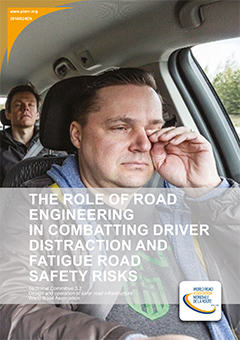The Role of Road Engineering in Combatting Driver Distraction and Fatigue Road Safety Risks

Driver distraction and fatigue are a problem because, as remarkable as our abilities are, we humans are fallible and our abilities have limitations. Driver distraction and fatigue incorporates elements of both limitations and fallibility. On top of our limitations and fallibilities, driving a vehicle is a surprisingly complex task that involves numerous elements.
A driver is required to move between these tasks to effectively deal with the ever changing road environment and traffic situation. As an example, where there is sufficient sight distance, a driver can gain enough understanding of the road ahead to enable them to check their speed, monitor vehicles around them, and perhaps even adjust the comfort settings within the vehicle. By contrast, with insufficient sight distance and a busy roadway, the driver may not have reasonable opportunity to check their speed and the vehicles around them, increasing their crash risk. If the driver adds to these tasks, such as by eating a hamburger while driving, they could compromise their ability to perform these tasks further.
Road engineers have been empirically considering driver limitations for many years. Through engineering judgement and the testing of different configurations and treatments, an extensive array of standards and guidelines have been developed which seek to lower the risk of a crash occurring to an acceptable level and to enable the relevant road to serve its intended transport purpose. They have been cautious of items with the potential to take a driver's attention away from the road (e.g. advertising), have developed sight distance requirements based upon research into the human driver's ability to react and developed road marking and signage standards and guidelines that are increasingly intuitive to understand, visible, readable and spaced so as to give driver's every chance of understanding the message and responding appropriately to it. As a result, the majority of today's "well designed" road environments are rather slow and static in that they give the driver much surplus time to perform the driving tasks.
The review of the extensive literature related to driver distraction and fatigue, found an overwhelming focus on driver education and enforcement strategies seeking to encourage drivers to avoid being distracted or fatigued while driving. This might explain why it was also found that many jurisdictions have sought to combat driver distraction and fatigue by raising awareness of the risk, establishing rules (such as to prohibit texting) and imposing significant penalties to discourage non-compliance. However, it was also found that driver distraction and fatigue are distinct and each comprise a number of separate elements that can be detrimental to road safety in different ways.
Information sheet
- Date: 2016
- Author(s): Comité technique 3.2 - Conception et exploitation d'infrastructures routières plus sûres Technical Committee 3.2 - Design and Operation of Safer Road Infrastructure
- Domain(s): Road Safety
- Type: 2016R24EN - Technical Report
- PIARC Ref.: 2016R24EN
- ISBN: 978-2-84060-419-8
- Number of pages: 73